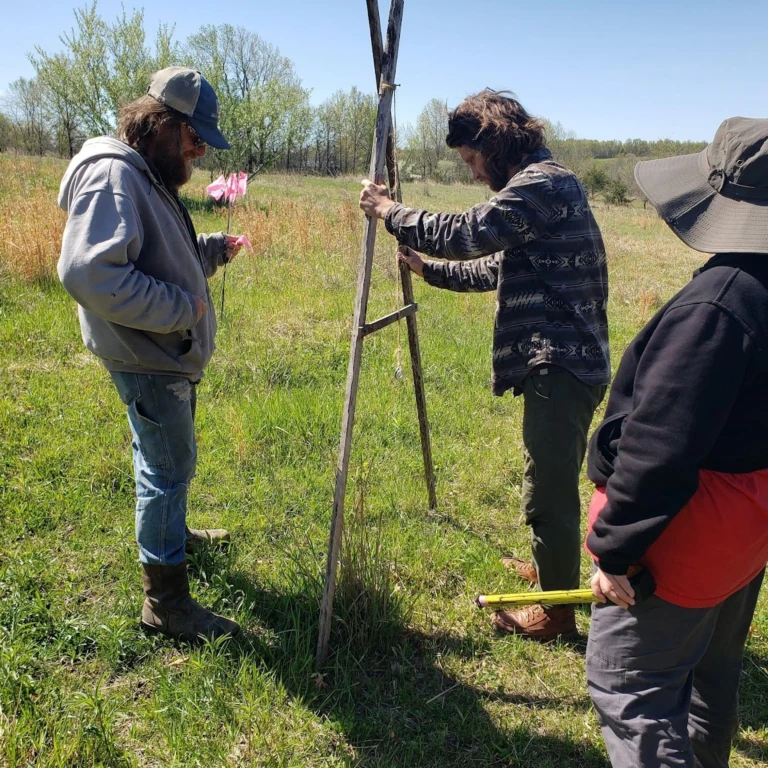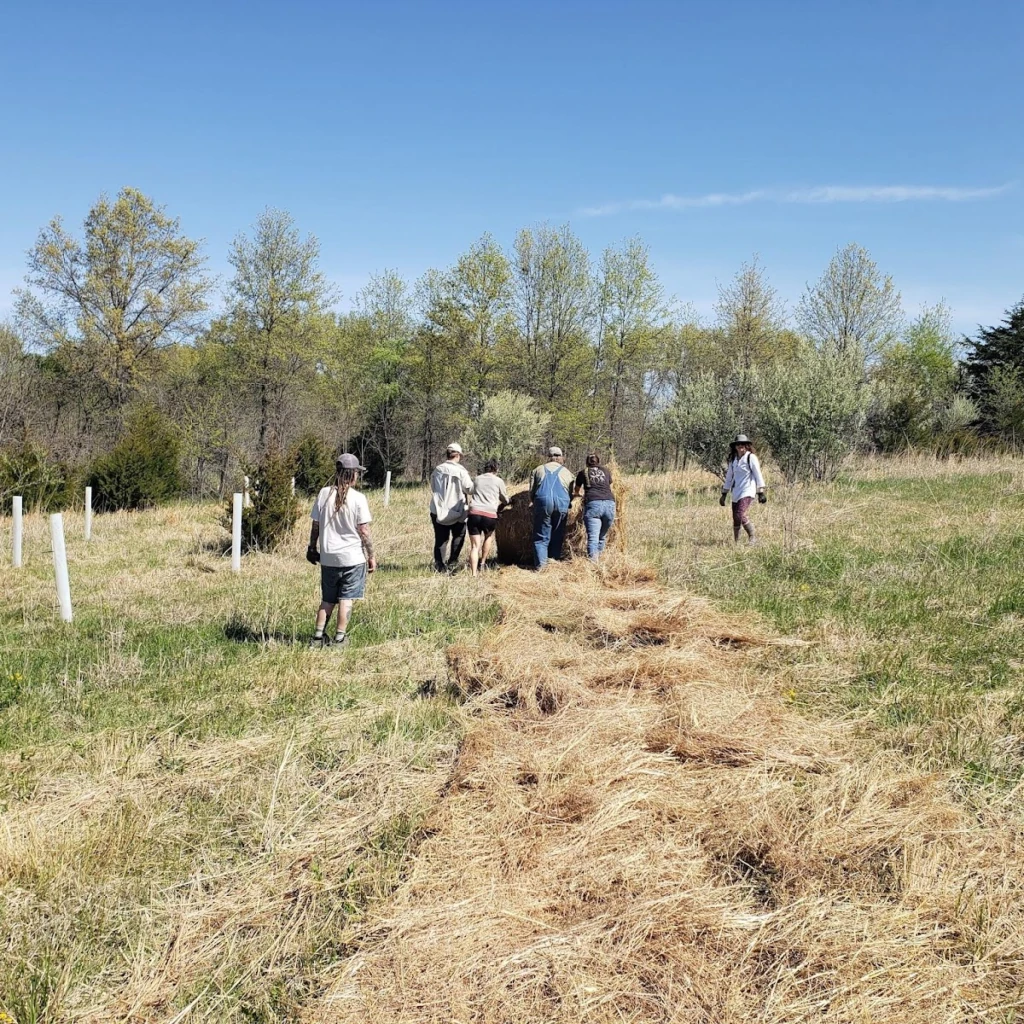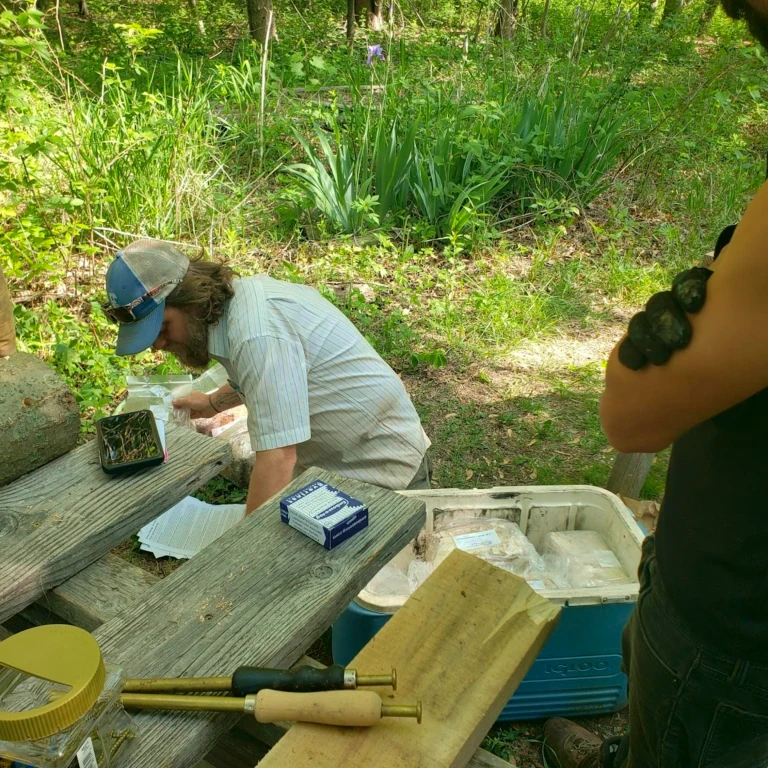DR’s Agroforestry Co-op Gets Rolling
Published: Tue, 06/06/23

DR’s Agroforestry Co-op Gets Rolling
We rolled the giant snail shell of hay down by the vineyard where we’d planted rows of thornless honey locust and mulberry trees. The “brake” was a two-by-four with nails in it, to be thrown under the impending roll when going downhill. If course correction was needed, rotational force was applied, and the bale turned on its vertical axis with little resistance.
The late morning sun was strong, but the air was bright and cool, not hot and muggy like it is now, a month later. The snail diminished, leaving a wet trail of hay that would be pitch-forked, gloved, and stomped into little bird’s nests, with a few fingers’ worth of space around the tree guard, a little roll of plastic zip-tied to a stake.
I read about Dancing Rabbit Ecovillage long before I saw it. DR is an informational ecology, I would argue, as well as a physical one. The growing environment of language and images on the internet (and in print) about this place is, like the village itself, also a kind of cooperatively tended space, a combination of the cultivated and the wild. Perennial species of themes that keep returning, narrative conventions and journalistic habits that get traded or gifted like garden starts. Chad here, with some agroforestry updates and thoughts about cooperative learning.
A couple days before the hay bale got unrolled, the agroforestry co-op had used an A-frame to plan out the lines where the trees would be planted. You would do so many flops of the frame, walking it along the points, making sure the plumb stayed true, plotting them out along natural land contours, laying stakes with pink flags.

Ben, Eric and Christina mark out where trees should be planted, following landscape contours. Photo by Chad.
Today, the second of June, we went out before dinner time, after the heat was bearable (there had been thunder, and a hot minute of rain, which the sun hadn’t even stopped shining for). This time we made tree guards out of rolls of what seemed to be chicken wire, counting about 31 inches (15 squares) and then cutting in between an edge, leaving the halves to twist around each other to keep the circle in place.
The stakes had pink tape around them. The tree starts, Kanza Pecan (Carya illinoinensis) and Neilson Shagbark (Carya ovata), also had ties the same color, with the name of the species. (One might, conveniently, have them in one’s pocket later, when writing an article.) After a space was cleared in the turn with a hoe, a hole was dug, the shovel proving more effective in the dry soil than the auger. Sometimes the roots of the starts would need to be clipped, if they were turning upward. Then the trees were planted, watered, with a cut-out square of cardboard to discourage weeds, and guarded with staked-in chicken wire.
I’ve been observing these digital and literal landscapes of the ecovillage for a while, and am happy for any opportunities to work with others tending, in small ways, to these real and imagined gardens, buildings, and fields. I’ll try to write gently here, with the same caution and respect as when I cut up trees with a chainsaw (as I’ve recently learned to do!). I won’t let any paragraphs fall in the wrong direction.
On a different morning a week later, people from DR’s agroforestry co-op and visitors get logs ready for inoculation with mushroom spawn by drilling holes about six inches apart, then turning the log on the sawhorse, and drilling another row, off-set, about four inches up, adjusting for the contours of knots or branchings. The logs then get passed on to those who shoot shiitake spores into the holes with specialized plungers, who in turn pass the log onto those who cover the hole with wax melted over a borrowed Coleman stove. Like the tree planting, the mushroom work party happened during the first visitor session.
“That’s your crank shaft!” Bob shouted to me this morning as I squeaked by on my bike. I pulled up to the bench by the community center in Rutledge.
“I know!” I said, pointing. “It’s that one. It came off in the field a few weeks ago.” I told him about how I found a new nut to replace it, but it kept coming loose. Every morning I would tighten it again. Jason, who is loaning me his drum kit, helped me find some kind of a washer to lock it in place. Bob offered to give me some kind of adhesive you could put on the threads. I squeaked away, happy to be surrounded by people with the knowledge, tools, and good will to keep me rolling along, however wobbly.
Things keep turning. Bales of hay, mushroom logs, phases of the moon. Wheels and broken crankshafts, trees and spores and gardens. The auger, turning through dry dirt, into the long future. Circles in circles, like rings in wood. Song circles, circling up before meals, the rotations of chores.
“You want to have everything already there, from the beginning, in the first few pages.” I was talking to an editing client about her first novel, about a family moving from Alsace, France to a farm in Iowa. “All the themes and conflicts that you’re going to roll out and develop through the book…” You have to plant a garden of words, and water it.
Dancing Rabbit, from my perspective, is a digital and physical landscape, but also a collection of informational and mechanical tools, related networks of social, technological, and ecological systems. One of the things I love about being here is having access to tools and resources without having to own them. You can go for long walks through land that isn’t yours. Time and space is shared. Cooperation lets you study and participate in systems without controlling them, or being controlled.
You can just learn, and write, and roll with things.
 |
Chad Hines is a writer and musician, and relatively new to Dancing Rabbit. For the weeks when Jason is in town, you can hear a wide range of live music coming from Jason’s yurt on the edge of the village, and Chad is probably there. The SubHub crew really appreciates having some music to work by! |
Dancing Rabbit Ecovillage, 1 Dancing Rabbit Lane, Rutledge, MO 63563, USA
Unsubscribe | Change Subscriber Options





